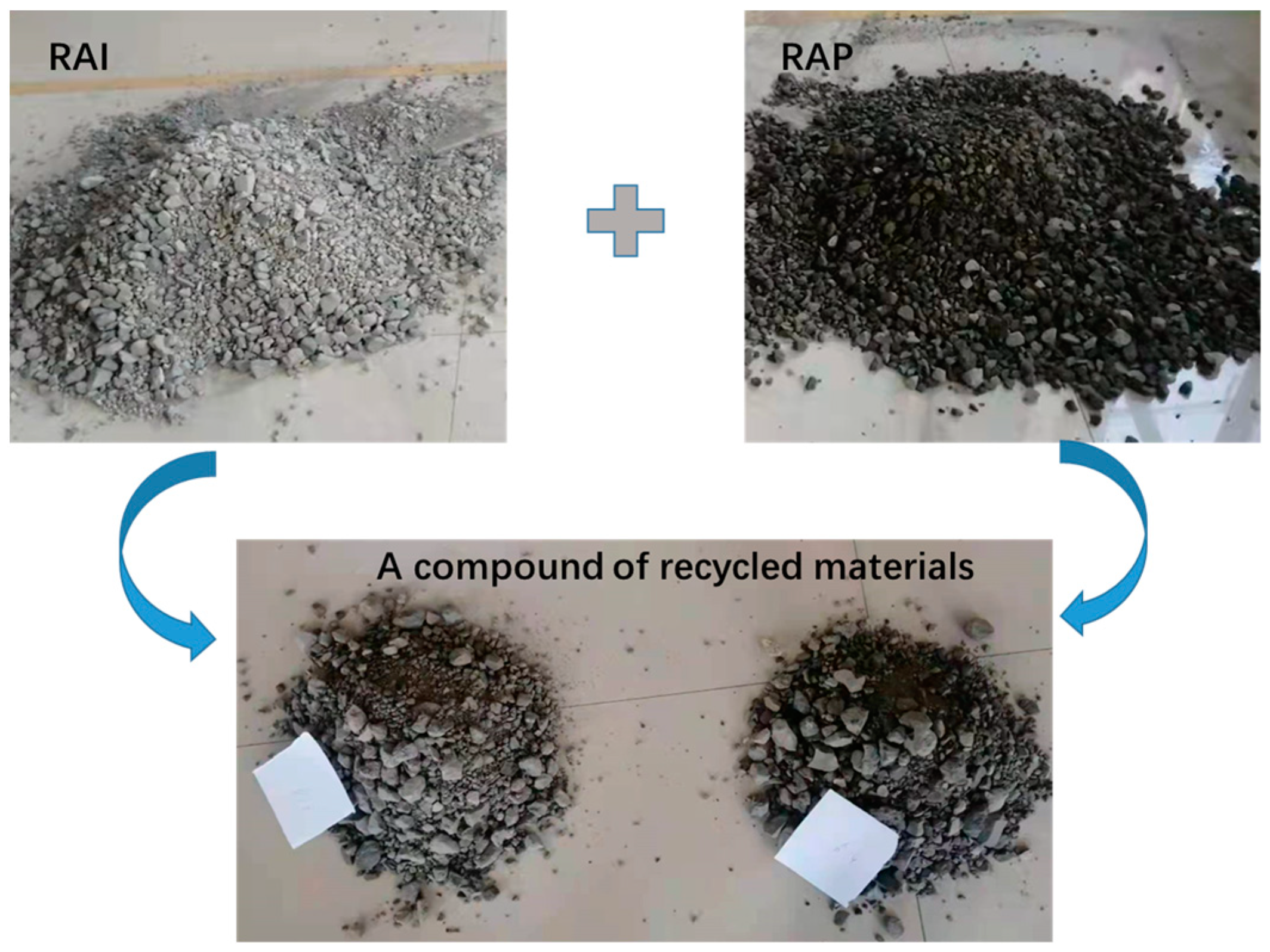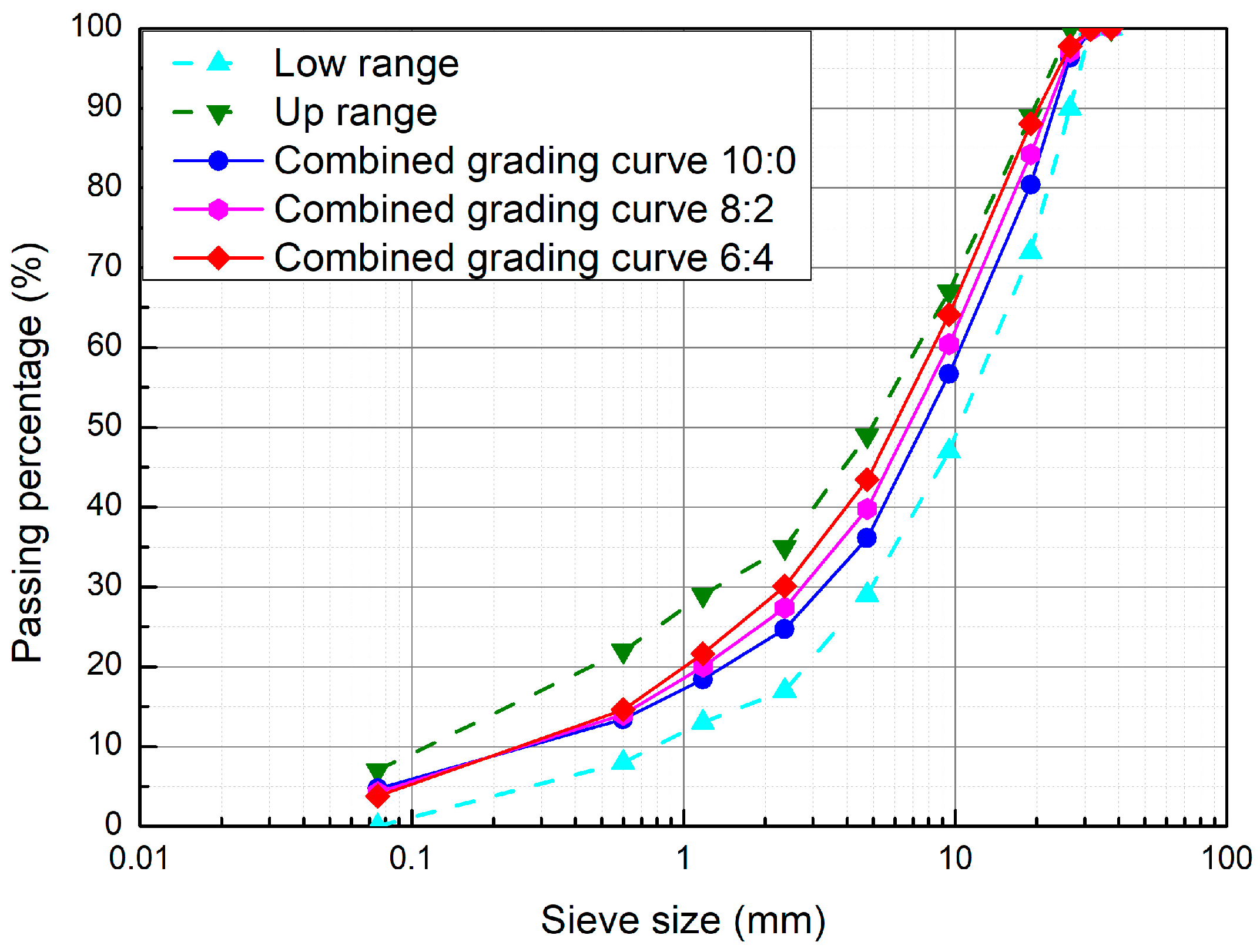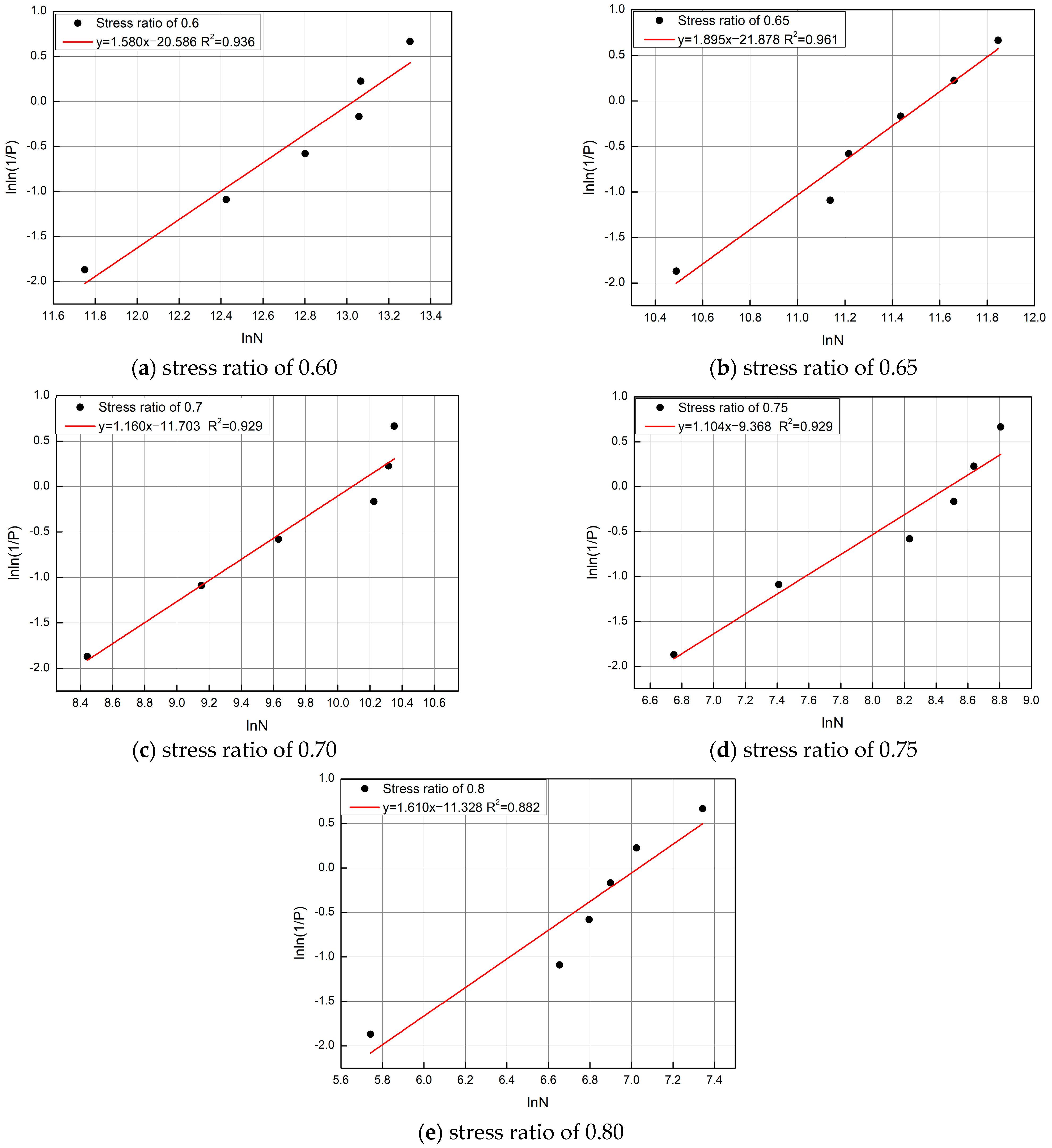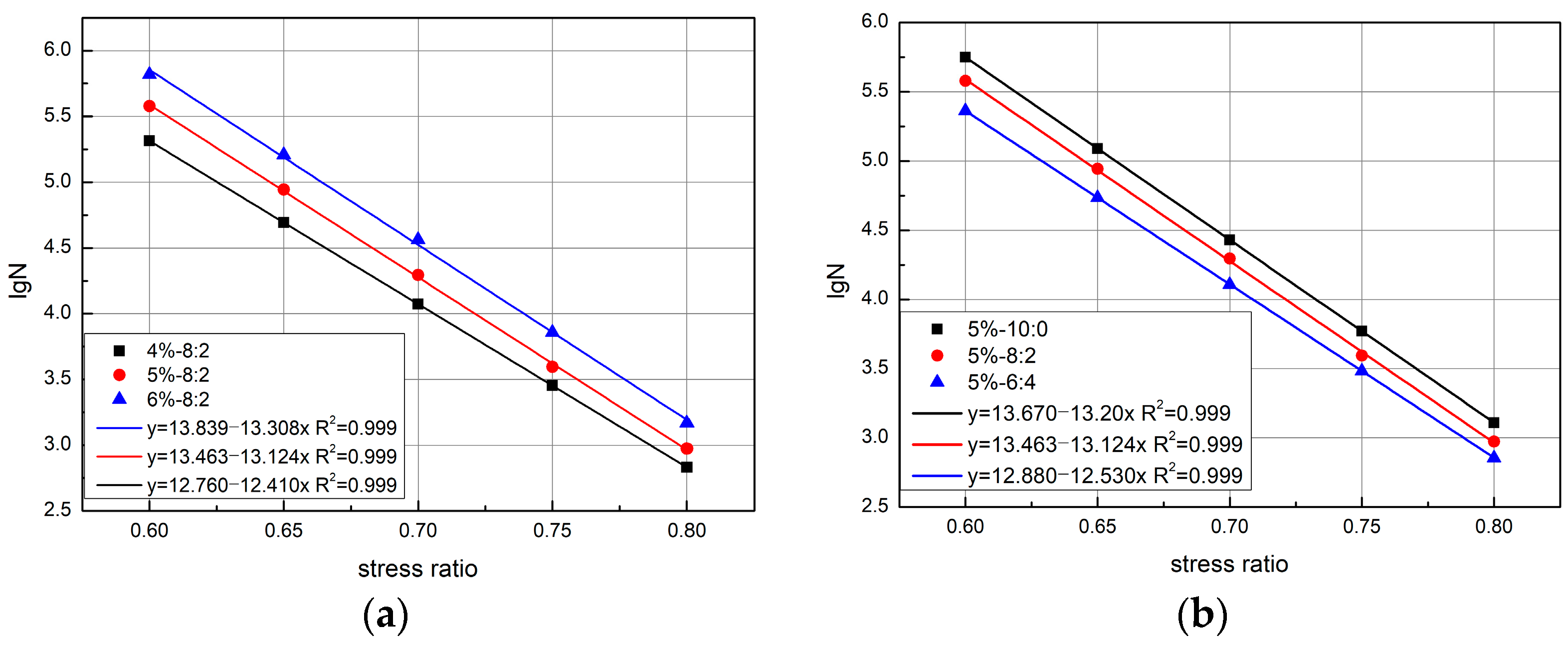Evaluation of the Fatigue Performance of Full-Depth Reclamation with Portland Cement Material Based on the Weibull Distribution Model
Abstract
1. Introduction
2. Materials and Methods
2.1. Raw Materials
2.2. Determining the Optimum Water Content and the Maximum Dry Density
2.3. Flexural Strength Test Method
2.4. Fatigue Test Method
2.5. Weibull Distribution
2.6. Fatigue Equation
3. Results and Discussion
3.1. Fatigue Test Results
3.2. Weibull Equation
3.3. Fatigue Equation
4. Conclusions
- (1)
- The fatigue life of cement-stabilized cold recycled mixtures adheres to a Weibull distribution, with correlation coefficients consistently surpassing 0.88.
- (2)
- As the cement content and base-to-surface ratio increase, the fatigue life of the mixture extends, though with an associated increase in stress sensitivity.
- (3)
- Comparisons with the fatigue equation model parameters for inorganic-binder-stabilized layers in the Chinese specifications for the design of highway asphalt pavement reveal that the mixture with a 4% cement content, and that with a 5% cement content and a low base-to-surface ratio, meet the criteria for inorganic-binder-stabilized soil. Furthermore, the mixture with a 5% cement content and a high base-to-surface ratio, along with that with a 6% cement content, satisfy the specifications for inorganic-binder-stabilized granular materials.
Author Contributions
Funding
Institutional Review Board Statement
Informed Consent Statement
Data Availability Statement
Conflicts of Interest
References
- Al-Khafaji, R.; Dulaimi, A.; Jafer, H.; Mashaan, N.S.; Qaidi, S.; Obaid, Z.S.; Jwaida, Z. Stabilization of Soft Soil by a Sustainable Binder Comprises Ground Granulated Blast Slag (GGBS) and Cement Kiln Dust (CKD). Recycling 2023, 8, 10. [Google Scholar] [CrossRef]
- Jaf, D.K.I.; Abdulrahman, P.I.; Mohammed, A.S.; Kurda, R.; Qaidi, S.M.A.; Asteris, P.G. Machine learning techniques and multi-scale models to evaluate the impact of silicon dioxide (SiO2) and calcium oxide (CaO) in fly ash on the compressive strength of green concrete. Constr. Build. Mater. 2023, 400, 132604. [Google Scholar]
- Fedrigo, W.; Nunez, W.P.; Visser, A.T. A review of full-depth reclamation of pavements with Portland cement: Brazil and abroad. Constr. Build. Mater. 2020, 262, 120540. [Google Scholar] [CrossRef]
- Jasienski, A.; Rens, L. In situ recycling with cement-the Belgian experience. In Proceedings of the Seminar on Road Pavement Recycling, Warsaw, Poland, 10–11 October 2002. [Google Scholar]
- Reeder, G.D.; Harrington, D.S.; Ayers, M.E.; Adaska, W. Guide to Full-Depth Reclamation (FDR) with Cement (No. SR1006P); National Concrete Pavement Technology Center: Ames, IA, USA, 2017. [Google Scholar]
- Jallu, M.; Arulrajah, A.; Saride, S.; Evans, R. Flexural fatigue behavior of fly ash geopolymer stabilized-geogrid reinforced RAP bases. Constr. Build. Mater. 2020, 254, 119263. [Google Scholar] [CrossRef]
- Saride, S.; Jallu, M. Effect of fly ash geopolymer on layer coefficients of reclaimed asphalt pavement bases. J. Transp. Eng. Part B Pavements 2020, 146, 04020033. [Google Scholar] [CrossRef]
- Portland Cement Association (PCA). Guide to Full Depth Reclamation (FDR) with Cement; Portland Cement Association (PCA): Skokie, IL, USA, 2005. [Google Scholar]
- Spanish Institute of Cement and its Applications. Pavement In Situ Recycling with Cement: Technical Guide; Spanish Institute of Cement and its Applications: Madrid, Spain, 2013. [Google Scholar]
- Wirtgen. Wirtgen Cold Recycling Technology; Wirtgen: Windhagen, Germany, 2012. [Google Scholar]
- South African National Roads Agency Limited (SANRAL). South African Pavement Engineering Manual; SANRAL: Pretoria, South Africa, 2014. [Google Scholar]
- Austroads. Mix Design for Stabilized Pavement Materials; Austroads Publication: Sydney, Australia, 2002. [Google Scholar]
- Franco, F.A.C.P. Mechanistic-Empirical Asphalt Pavement Design Method; Federal University of Rio de Janeiro: Rio de Janeiro, Brazil, 2007. [Google Scholar]
- Jiang, Y.; Liu, H.; Xue, J. Fatigue performance of vertical vibration compacted cement-stabilized recycled pavement materials. J. Test. Eval. 2018, 46, 2251–2264. [Google Scholar] [CrossRef]
- López, M.A.C.; Fedrigo, W.; Kleinert, T.R.; Matuella, M.F.; Núñez, W.P.; Ceratti, J.A.P. Flexural fatigue evaluation of cement-treated mixtures of reclaimed asphalt pavement and crushed aggregates. Constr. Build. Mater. 2018, 158, 320–325. [Google Scholar] [CrossRef]
- Guthrie, W.S.; Brown, A.V.; Eggett, D.L. Cement stabilization of aggregate base material blended with reclaimed asphalt pavement. Transp. Res. Rec. 2007, 2026, 47–53. [Google Scholar] [CrossRef]
- Yuan, D.; Nazarian, S.; Hoyos, L.R.; Puppala, A.J. Evaluation and mix design of cement-treated base materials with high content of reclaimed asphalt pavement. Transp. Res. Rec. 2011, 2212, 110–119. [Google Scholar] [CrossRef]
- Dixon, P.A.; Guthrie, W.S.; Eggett, D.L. Factors affecting strength of road base stabilized with cement slurry or dry cement in conjunction with full-depth reclamation. Transp. Res. Rec. 2012, 2310, 113–120. [Google Scholar] [CrossRef]
- Fedrigo, W.; Núñez, W.P.; Kleinert, T.R.; Matuella, M.F.; Ceratti, J.A.P. Strength, shrinkage, erodibility and capillary flow characteristics of cement-treated recycled pavement materials. Int. J. Pavement Res. Technol. 2017, 10, 393–402. [Google Scholar] [CrossRef]
- Syed, I.M. Full-Depth Reclamation with Portland Cement: A Study of Long-Term Performance; Portland Cement Association: Washington, DC, USA, 2007. [Google Scholar]
- Jiang, Y.; Cao, F.; Chen, Z.; Fang, J. Fatigue performance and application of cement stabilized macadam shaped with vertical vibration test method. J. Chang. Univ. 2014, 34, 1–6. [Google Scholar]
- Osgood, C.C. Fatigue Design: International Series on the Strength and Fracture of Materials and Structures; Elsevier: Amsterdam, The Netherlands, 2013. [Google Scholar]
- Smith, R.L. Weibull regression models for reliability data. Reliab. Eng. Syst. Saf. 1991, 34, 55–76. [Google Scholar] [CrossRef]
- Enkhmunkh, N.; Kim, G.W.; Hwang, K.J.; Hyun, S.H. A parameter estimation of Weibull distribution for reliability assessment with limited failure data. In Proceedings of the International Forum on Strategic Technology, Ulaanbaatar, Mongolia, 3–6 October 2007; pp. 39–42. [Google Scholar]
- Guo, X.; Qiao, H.; Zhu, B.; Wang, P.; Wen, S. Accelerated life testing of concrete based on three-parameter Weibull stochastic approach. KSCE J. Civ. Eng. 2019, 23, 1682–1690. [Google Scholar] [CrossRef]
- Wang, C.; Fu, P.; Liu, Z.; Xu, Z.; Wen, T.; Zhu, Y.; Jiang, J. Study of the Durability Damage of Ultrahigh Toughness Fiber Concrete Based on Grayscale Prediction and the Weibull Model. Buildings 2022, 12, 746. [Google Scholar] [CrossRef]
- Murali, G.; Santhi, A.S.; Ganesh, G.M. Impact resistance and strength reliability of fiber reinforced concrete using two parameter weibull distribution. J. Eng. Appl. Sci 2014, 9, 554–559. [Google Scholar]
- Sun, J.; Yu, J.M.; Zhao, H.S. Two-parameter Weibull distribution theory testing analysis in fatigue life of asphalt mixture. Appl. Mech. Mater. 2011, 97, 45–48. [Google Scholar]
- Zhu, Z.; Zhang, C.; Meng, S.; Shi, Z.; Tao, S.; Zhu, D. A statistical damage constitutive model based on the Weibull distribution for alkali-resistant glass fiber reinforced concrete. Materials 2019, 12, 1908. [Google Scholar] [CrossRef]
- Research Institute of Highway Ministry of Transport of China. Technical Specifications for Highway Asphalt Pavement Recycling JTG/T 5521—2019; Ministry of Transportation: Beijing, China, 2019. [Google Scholar]
- China Building Materials Federation. Test Methods for Water Requirement of Normal Consistency, Setting Time and Soundness of the Portland Cement; Standardization Administration of China: Beijing, China, 2012. [Google Scholar]
- China Building Materials Federation. Test method of Cement Mortar Strength (ISO Method); Standardization Administration of China: Beijing, China, 2022. [Google Scholar]
- Research Institute of Highway Ministry of Transport of China. Test Methods of Materials Stabilized with Inorganic Binders for Highway Engineering JTG E51-2009; Ministry of Transportation: Beijing, China, 2009. [Google Scholar]
- You, F.; Nian, M.; Zheng, J.; Luo, S. Study on flexural fatigue performance of recycled aggregate concrete. J. Build. Struct. 2022, 43, 134. [Google Scholar]
- Zhu, X.; Chen, X.; Pan, F. Reliability analysis of fatigue life of self-compacting concrete subjected to freeze-thaw damage. J. Harbin Inst. Technol. 2023, 55, 118. [Google Scholar]
- Wang, M.; Yu, Q.; Xiao, Y. Experimental investigation of macro-and meso-scale compaction characteristics of unbound permeable base materials. Chin. J. Rock Mech. Eng. 2022, 41, 1701–1716. [Google Scholar]








| Sieve Size (mm) | 37.5 | 31.5 | 26.5 | 19 | 9.5 | 4.75 | 2.36 | 1.18 | 0.6 | 0.075 |
|---|---|---|---|---|---|---|---|---|---|---|
| RIA Passing Percentage (%) | 100 | 99.7 | 96.3 | 80.4 | 56.7 | 36.1 | 24.7 | 18.4 | 13.4 | 4.7 |
| RAP Passing Percentage (%) | 100 | 100 | 100 | 99.5 | 75.3 | 54.4 | 38.1 | 26.4 | 16.4 | 2.4 |
| Testing Item | Technical Indicator | Testing Result | Testing Method | |
|---|---|---|---|---|
| Setting Time (min) | Initial Setting | ≥180 | 218 | GB/T 1346-2011 [31] |
| Final Setting | ≤600 | 385 | ||
| Flexural Strength (MPa) | 3 d | ≥3.5 | 3.8 | GB/T 17671-2021 [32] |
| 28 d | ≥6.5 | 10.6 | ||
| Compressive Strength (MPa) | 3 d | ≥17.0 | 19.9 | |
| 28 d | ≥42.5 | 45.5 | ||
| Cement Content (%) | Base-to-Surface Ratio | Optimal Water Content (%) | Maximum Dry Density (g/cm3) |
|---|---|---|---|
| 4 | 8:2 | 5.9 | 2.242 |
| 5 | 8:2 | 6.6 | 2.246 |
| 6 | 8:2 | 6.8 | 2.240 |
| 5 | 10:0 | 7.1 | 2.236 |
| 5 | 6:4 | 6.2 | 2.250 |
| Cement Content (%) | Base-to-Surface Ratio | Flexural Strength (MPa) | Stress Ratio | Maximum Load (N) | Minimum Load (N) |
|---|---|---|---|---|---|
| 5 | 10:0 | 1.43 | 0.6 | 2850 | 285 |
| 0.65 | 4000 | 400 | |||
| 0.7 | 3350 | 335 | |||
| 0.75 | 3575 | 358 | |||
| 0.8 | 3800 | 380 | |||
| 8:2 | 1.27 | 0.6 | 2540 | 250 | |
| 0.65 | 2750 | 275 | |||
| 0.7 | 3000 | 300 | |||
| 0.75 | 3175 | 320 | |||
| 0.8 | 3400 | 340 | |||
| 6:4 | 1.07 | 0.6 | 2150 | 215 | |
| 0.65 | 2300 | 230 | |||
| 0.7 | 2500 | 250 | |||
| 0.75 | 2675 | 270 | |||
| 0.8 | 2850 | 285 | |||
| 4 | 8:2 | 0.87 | 0.6 | 1740 | 170 |
| 0.65 | 1885 | 190 | |||
| 0.7 | 2030 | 200 | |||
| 0.75 | 2175 | 220 | |||
| 0.8 | 2320 | 230 | |||
| 6 | 8:2 | 1.49 | 0.6 | 3000 | 300 |
| 0.65 | 3250 | 320 | |||
| 0.7 | 3500 | 350 | |||
| 0.75 | 3725 | 370 | |||
| 0.8 | 4000 | 400 |
| Base-to- Surface Ratio | Cement Content (%) | Stress Ratio | Fatigue Life Values | SD | COV/% | |||||
|---|---|---|---|---|---|---|---|---|---|---|
| 1# | 2# | 3# | 4# | 5# | 6# | |||||
| 8:2 | 4 | 0.60 | 97,095 | 130,489 | 145,949 | 177,206 | 230,677 | 292,033 | 26,669 | 14.9 |
| 0.65 | 17,470 | 34,993 | 38,377 | 57,759 | 71,106 | 74,847 | 8394 | 17.1 | ||
| 0.70 | 4465 | 6265 | 9099 | 11,262 | 12,815 | 17,716 | 1780 | 17.3 | ||
| 0.75 | 983 | 1422 | 2587 | 3186 | 3670 | 4794 | 530 | 19.1 | ||
| 0.80 | 243 | 320 | 478 | 662 | 839 | 1027 | 114 | 19.1 | ||
| 5 | 0.60 | 126,789 | 248,973 | 362,436 | 468,513 | 472,845 | 597,931 | 63,583 | 16.8 | |
| 0.65 | 35,893 | 68,725 | 74,321 | 92,574 | 115,932 | 115,932 | 11,492 | 13.7 | ||
| 0.70 | 4643 | 9431 | 15,239 | 27,543 | 30,186 | 31,267 | 4273 | 21.7 | ||
| 0.75 | 854 | 1653 | 3764 | 4971 | 5642 | 6680 | 854 | 21.7 | ||
| 0.80 | 312 | 776 | 894 | 991 | 1123 | 1545 | 151 | 16.1 | ||
| 6 | 0.60 | 360,646 | 446,615 | 511,095 | 688,262 | 733,906 | 994,362 | 86,109 | 13.8 | |
| 0.65 | 61,508 | 87,748 | 89,413 | 111,783 | 180,187 | 241,178 | 25,453 | 19.8 | ||
| 0.70 | 14,921 | 18,540 | 22,589 | 28,545 | 32,366 | 42,181 | 3716 | 14.0 | ||
| 0.75 | 3797 | 4242 | 5956 | 7624 | 8113 | 9382 | 831 | 12.7 | ||
| 0.80 | 683 | 919 | 1093 | 1272 | 1695 | 2117 | 197 | 15.2 | ||
| 6:4 | 5 | 0.60 | 93,195 | 157,369 | 167,242 | 238,183 | 224,717 | 290,624 | 26,057 | 13.3 |
| 0.65 | 24,191 | 31,923 | 43,586 | 52,725 | 71,603 | 73,830 | 7592 | 15.3 | ||
| 0.70 | 5282 | 6838 | 11,423 | 15,618 | 15,968 | 20,472 | 2177 | 17.3 | ||
| 0.75 | 1468 | 1585 | 2282 | 2738 | 3980 | 4123 | 428 | 15.9 | ||
| 0.80 | 343 | 413 | 584 | 598 | 829 | 987 | 91 | 14.6 | ||
| 10:0 | 5 | 0.60 | 232,001 | 220,989 | 530,616 | 520,816 | 688,984 | 930,967 | 101,367 | 19.5 |
| 0.65 | 39,815 | 75,565 | 80,040 | 77,894 | 130,942 | 204,822 | 21,755 | 21.4 | ||
| 0.70 | 9223 | 14,508 | 23,229 | 23,134 | 32,324 | 40,851 | 4291 | 18.0 | ||
| 0.75 | 1889 | 2476 | 3447 | 4309 | 6232 | 11,100 | 1265 | 25.8 | ||
| 0.80 | 416 | 723 | 733 | 1173 | 1877 | 2108 | 255 | 21.8 | ||
| Base-to-Surface Ratio | Cement Content | Stress Ratio | α | β | R2 |
|---|---|---|---|---|---|
| 8:2 | 4% | 0.60 | 2.272 | 27.801 | 0.972 |
| 0.65 | 1.633 | 17.927 | 0.956 | ||
| 0.70 | 1.829 | 17.180 | 0.992 | ||
| 0.75 | 1.504 | 12.190 | 0.975 | ||
| 0.80 | 1.624 | 10.644 | 0.983 | ||
| 5% | 0.60 | 1.580 | 20.586 | 0.936 | |
| 0.65 | 1.895 | 21.878 | 0.961 | ||
| 0.70 | 1.160 | 11.703 | 0.929 | ||
| 0.75 | 1.104 | 9.368 | 0.929 | ||
| 0.80 | 1.610 | 11.328 | 0.882 | ||
| 6% | 0.60 | 2.437 | 32.839 | 0.964 | |
| 0.65 | 1.731 | 20.644 | 0.910 | ||
| 0.70 | 2.391 | 24.684 | 0.983 | ||
| 0.75 | 2.445 | 21.809 | 0.954 | ||
| 0.80 | 2.215 | 16.192 | 0.981 | ||
| 6:4 | 5% | 0.60 | 2.211 | 27.262 | 0.942 |
| 0.65 | 2.042 | 22.386 | 0.977 | ||
| 0.70 | 1.694 | 16.284 | 0.959 | ||
| 0.75 | 2.007 | 16.162 | 0.931 | ||
| 0.80 | 2.251 | 14.813 | 0.964 | ||
| 10:0 | 5% | 0.60 | 1.477 | 19.718 | 0.881 |
| 0.65 | 1.559 | 18.244 | 0.893 | ||
| 0.70 | 1.679 | 17.211 | 0.978 | ||
| 0.75 | 1.388 | 12.015 | 0.939 | ||
| 0.80 | 1.433 | 10.375 | 0.950 |
| Base-to-Surface Ratio | Cement Content | Stress Ratio | Fatigue Life at Different Reliability Levels | ||||
|---|---|---|---|---|---|---|---|
| 50% | 60% | 70% | 80% | 90% | |||
| 8:2 | 4% | 0.60 | 175,202 | 153,180 | 130,782 | 106,391 | 76,467 |
| 0.65 | 46,797 | 38,819 | 31,154 | 23,376 | 14,764 | ||
| 0.70 | 9844 | 8331 | 6845 | 5296 | 3513 | ||
| 0.75 | 2594 | 2117 | 1667 | 1221 | 741 | ||
| 0.80 | 560 | 464 | 372 | 278 | 175 | ||
| 5% | 0.60 | 361,184 | 307,807 | 237,192 | 179,848 | 109,626 | |
| 0.65 | 103,272 | 75,933 | 59,940 | 49,567 | 31,495 | ||
| 0.70 | 24,072 | 15,092 | 9898 | 8513 | 3459 | ||
| 0.75 | 4844 | 3607 | 1904 | 2404 | 631 | ||
| 0.80 | 1137 | 721 | 599 | 431 | 281 | ||
| 6% | 0.60 | 613,265 | 541,064 | 466,903 | 385,153 | 283,062 | |
| 0.65 | 122,276 | 102,510 | 83,300 | 63,529 | 41,181 | ||
| 0.70 | 26,082 | 22,956 | 19,754 | 16,236 | 11,863 | ||
| 0.75 | 6443 | 5687 | 4910 | 4052 | 2981 | ||
| 0.80 | 1266 | 1103 | 938 | 759 | 541 | ||
| 6:4 | 5% | 0.60 | 192,173 | 167,391 | 142,287 | 115,087 | 81,960 |
| 0.65 | 48,285 | 41,580 | 34,872 | 27,715 | 19,190 | ||
| 0.70 | 12,026 | 10,044 | 8125 | 6160 | 3956 | ||
| 0.75 | 2620 | 2250 | 1882 | 1489 | 1024 | ||
| 0.80 | 613 | 535 | 456 | 370 | 265 | ||
| 10:0 | 5% | 0.60 | 489,591 | 398,191 | 312,230 | 227,286 | 136,749 |
| 0.65 | 95,229 | 78,301 | 62,191 | 46,037 | 28,452 | ||
| 0.70 | 22,700 | 18,928 | 15,283 | 11,559 | 7394 | ||
| 0.75 | 4422 | 3549 | 2739 | 1953 | 1137 | ||
| 0.80 | 1078 | 871 | 678 | 488 | 289 | ||
| Cement Content | Base-to-Surface Ratio | lg N = a – kσ/S | ||
|---|---|---|---|---|
| a | k | R2 | ||
| 5% | 10:0 | 13.670 | 13.200 | 0.999 |
| 8:2 | 13.463 | 13.124 | 0.999 | |
| 6:4 | 12.880 | 12.530 | 0.999 | |
| 4% | 8:2 | 12.760 | 12.410 | 0.999 |
| 6% | 8:2 | 13.839 | 13.308 | 0.999 |
| Recommended by Regulations | Inorganic-Binder-Stabilized Granular Material | 13.24 | 12.52 | / |
| Inorganic-Binder-Stabilized Soil | 12.18 | 12.79 | / | |
Disclaimer/Publisher’s Note: The statements, opinions and data contained in all publications are solely those of the individual author(s) and contributor(s) and not of MDPI and/or the editor(s). MDPI and/or the editor(s) disclaim responsibility for any injury to people or property resulting from any ideas, methods, instructions or products referred to in the content. |
© 2024 by the authors. Licensee MDPI, Basel, Switzerland. This article is an open access article distributed under the terms and conditions of the Creative Commons Attribution (CC BY) license (https://creativecommons.org/licenses/by/4.0/).
Share and Cite
Li, Y.; Zhao, L.; Gao, J.; Ru, Y.; Zhang, H. Evaluation of the Fatigue Performance of Full-Depth Reclamation with Portland Cement Material Based on the Weibull Distribution Model. Coatings 2024, 14, 437. https://doi.org/10.3390/coatings14040437
Li Y, Zhao L, Gao J, Ru Y, Zhang H. Evaluation of the Fatigue Performance of Full-Depth Reclamation with Portland Cement Material Based on the Weibull Distribution Model. Coatings. 2024; 14(4):437. https://doi.org/10.3390/coatings14040437
Chicago/Turabian StyleLi, Yongxiang, Longwei Zhao, Junfeng Gao, Yanyan Ru, and Haiwei Zhang. 2024. "Evaluation of the Fatigue Performance of Full-Depth Reclamation with Portland Cement Material Based on the Weibull Distribution Model" Coatings 14, no. 4: 437. https://doi.org/10.3390/coatings14040437
APA StyleLi, Y., Zhao, L., Gao, J., Ru, Y., & Zhang, H. (2024). Evaluation of the Fatigue Performance of Full-Depth Reclamation with Portland Cement Material Based on the Weibull Distribution Model. Coatings, 14(4), 437. https://doi.org/10.3390/coatings14040437







